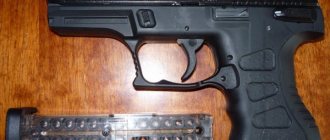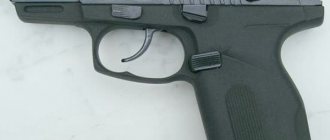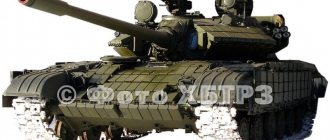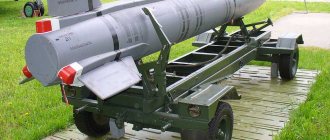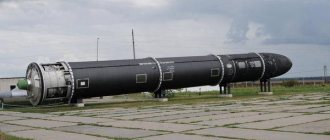The Skif missile is a nuclear weapon in the Russian Navy. This weapon is strictly classified, in this article we will try to find out and consider its main characteristics. Many assume that the Skif missile is a modern prototype of the Sineva or Liner ICBM.
The missile can remain at the bottom of the ocean or sea for many years, and at a certain moment, on command, hit the specified target, flying at hypersonic speed and skirting the terrain. This missile can hit both sea and land targets with equal accuracy.
History of the rocket
The idea of launching ballistic missiles permanently based at the bottom of reservoirs arose in the mid-60s. last century, but no specific developments were carried out. The attractiveness of placing strategic weapons on the bottom was the complete secrecy of their base locations and invisibility for the enemy’s submarine fleet. This would also make it possible to significantly reduce the material costs associated with their protection and protection from possible damage.
In the United States, this idea was abandoned, giving preference to mine-based complexes. And in the USSR, from the late 80s, they began developing missiles with underwater deployment and already in the early 90s, the State Missile Center named after. Makeev received an order to carry out work on this type of weapon from the Russian War Ministry.
Around 2005 The first experimental units of bottom complexes were produced.
In 2007-2008 the creators tested the strength of the components and reliability of the Skif units, its ability to withstand hydrodynamic overloads, in 2009. samples were sent for revision after trial tests with the participation of the underwater submarine "Sarov" pr.20120. Subsequent tests, carried out in 2022, turned out to be quite successful, so the new weapon entered service with the Russian Navy.
Specialists from the MT Rubin design bureau in St. Petersburg and the Miass State Research Center named after them took an active part in the design work on the Skif ballistic missile. Makeev under the leadership of A.P. Shalneva.
Modifications
Designers from Ukraine have also developed unique models of ATGMs: - a system for launching guided anti-tank missiles used by Kombat-type tanks; — guided anti-tank launchers for light armored vehicles of the Stunga type;
These ATGM models have already undergone adaptation processes for the use of NATO caliber, which allows the installations to be exported to other countries.
Portable anti-tank systems of the "Skif" type are based on these missiles, as a lighter version of the complex, called "Corsair". Ukrainian ground forces are already armed with these ATGMs. There is the possibility of placing this weapon on any combat helicopter.
What is “Skif” and how to deal with it
Moreover, the Skif bottom-launched ballistic missile does not violate the seabed treaty in any way. After all, it does not affect the internal waters of Russia - and they include, for example, the White Sea (up to 343 meters deep) or Baikal (up to 1642 meters deep). There are ten lakes in Russia that are deeper than two hundred meters. With the White Sea and the coastal waters of the Arctic Ocean, there are more than enough places to legally put a new missile on combat duty.
The Skif bottom missile is, in fact, a conventional long-range ballistic missile for a submarine. It is stored on the seabed in a special container that isolates it from pressure and provides communication with a ground control center. When a signal is given from the shore, the container blows through the tanks, much like in a submarine when surfacing, and floats to a depth of 50 meters. From there, the rocket launches in the same way as from aboard a submarine.
The advantages of bottom-based aircraft over a submarine are obvious. The nuclear submarine is much more expensive than its ballistic missiles, and you can try to track it using hydroacoustics. In the event of a conflict, the nuclear submarine can be destroyed. But the bottom rocket is not. It is useless to throw thermonuclear charges into Baikal. The thickness of the water effectively weakens a nuclear strike, and in a durable container, the Skif will survive even an explosion directly above it. In theory, it is possible to develop a miracle rocket that will fly to a distant Russian lake and drop a diving deep torpedo with a nuclear warhead. But tracking the Skif at the bottom of Lake Baikal is not just difficult for the United States - it is a fundamentally unsolvable problem. So the miracle rocket won’t help either.
Skif also has advantages over silo-based missiles. You can try to disable the mine with a precise nuclear strike. Yes, the mines have defense systems, but still, at least in theory, they can be attacked. In addition, heavy-duty (to withstand a nuclear attack) concrete shafts and their active protection systems require a lot of money. The “Skiff” lying at the bottom does not need all this. That is, with the same money, “Skifs” can be deployed simply more.
From the US point of view this is very bad. It is very difficult to launch a disarming first nuclear strike on nuclear submarines and ICBM silos. According to Skif, it’s impossible.
Portable ATGM "SKIF" (Belarus-Ukraine)
The main purpose of the SKIF complex is the destruction of enemy mobile and stationary armored vehicles provided with combined, spaced, monolithic armor protection. This includes armored vehicles with dynamic protection, helicopters and pillboxes.
The man-portable ATGM is a modular design that includes an anti-tank missile, a control and guidance system. The main developer is the Kiev design bureau "Luch".
The Ukrainian man-portable missile system is a high-precision means of destroying armored vehicles and enemy targets. The ATGM developed by the Kyiv design bureau "Luch" has formed around itself an association of defense, electronic and precision mechanics enterprises. The ATGM itself is created according to a modular design, which corresponds to modern trends in weapons production. This has expanded the possibilities of using ATGMs, since missile components or launch vehicle components can be changed in accordance with customer requirements.
Ukrainian designers also created the following unique ATGMs: - anti-tank guided missiles for arming Kombat tank vehicles; — anti-tank guided missiles for arming light armored vehicles “Stunga”. These ATGMs have already been “optimized” for NATO caliber for the supply of missiles and systems for export.
Based on these missiles, the Skif portable anti-tank missile system and the Corsair lightweight portable system were created. These portable ATGMs are in service with the Ukrainian ground forces. It is possible to install the complexes on any combat helicopters.
The Skif portable anti-tank missile system was created jointly with the Belarusian defense industry. It was demonstrated at the Minsk arms salon "MILEX-2011". Portable ATGMs have already been successfully supplied to some foreign customers. Many examples of ATGMs and ATGMs are installed on exported equipment, which increases the competitiveness of armored vehicles.
The Skif portable multi-purpose ATGM for attack purposes has the ability to connect to automated battle control systems. It has the properties of anti-tank and artillery weapons in the near tactical zone. It affects all modern types of light armored vehicles provided with modern types of armor protection.
One of the main features is the guidance of a guided missile at a selected target from a closed position or shelter, which increases the survivability of the complex’s crew. Composition of the complex: - launcher, weighing 28 kilograms; - TPK with a rocket, weighing 29.5 kilograms; — a device for guiding the PN-S missile, weighing 16 kilograms; — reconciliation module.
Guided anti-tank missile of 130mm caliber, TPK length 1.36 meters, TPK diameter - 14 centimeters. The missile is equipped with a tandem, cumulative (HE, thermobaric) warhead. The temperature range for use of the complex is from +50 to -40 degrees.
The missile is controlled using a laser beam, with a programmable direction determined by the flight path “exceeding” the line of sight. This allows you to avoid illumination of the rocket flight display and eliminate the main interference (smoke and dust from the rocket launch) from the field of view. The complex's gunner constantly keeps the target on the remote control display, marking the target with an aiming mark. The mode also increases protection from various systems that interfere with the laser beam. ATGMs can only be detected during the final phase of approach to the target.
The range of use of the portable complex "Skif" is from 0.1 to 5.5 kilometers. Armor penetration behind dynamic type protection is more than 800mm; when used in ATGMs, ATGMs of 152mm caliber, armor penetration is more than 1000mm. The ATGM uses a semi-automatic laser guidance system. The built-in laser rangefinder provides distance measurement up to seven kilometers (±5 meters).
Main advantages:
— increased accuracy of target destruction; — hitting targets in the daytime and at night; — hitting targets from a zone beyond the reach of the target’s weapons (increased range); — increased survivability of the ATGM crew due to the use of a remote remote control (up to 100 meters); — the possibility of an auto-tracking mode classifies ATGMs into the modern “fire and forget” class of weapons; - a wide range of possible carriers - ground-based wheeled and tracked vehicles, helicopters and surface boats.
Main characteristics:
- caliber -130mm; — TPK length – 1.36 meters; - diameter of the TPK - 14 centimeters; - firing range day/night - up to 5.5/3 kilometers; — “dead zone” — 100 meters; - maximum flight time - 23 seconds; — cumulative tandem warhead; — remote control weight – 10 kilograms; — The weight of the thermal imaging module is 6 kilograms.
Sources of information: https://www.luch.kiev.ua/russian/main.htm https://www.military-informer.narod.ru/antitank-skif.html
Construction of the Skif complex
There are several versions of the purpose of the Skif complex. According to the first of them, this is a system that is unloaded from the B-90 Sarov submarine and is in sleep mode until a command is received to launch from the bottom of the reservoir.
The second option is that the missile is placed in a special transport container with the function of launching cruise and ballistic warheads, previously located in them at great depth.
According to the third option, a carrier projectile equipped with a rocket engine, on command, travels a certain path to the intended target under water, and then launches a medium-range missile at an object located on the ground.
Characteristics
Having reached a depth of 50 meters, a missile is launched from a container to destroy a potential enemy. Start from an underwater position. According to American experts, the Skif missile is an improved version of the Sineva and Liner missiles.
Only Sineva and Liner are launched from Dolphin submarines. Skif does not require the presence of a submarine, which makes maintenance inexpensive. If we take the Liner rocket, then it has a total throw weight of 2 megatons (125 Hiroshima).
Submarine missiles are limited in size. With Skif, it becomes possible to avoid such restrictions. Therefore, the throwing weight of the Skif is no less than 5 megatons.
The range of the missile, based on the range of the Liner, is no less than 10,000 km. That is, it will reach anywhere in the USA.
Skif missile testing process
It was known that already in 2016, tests of this missile were carried out. The submarine “Zvezdochka” was used to move the Skif if it did not lie in the designated place. Sarov submarines ensured safe movement under water, which was made possible thanks to a special calibration of the system. But from that moment on, there was absolutely no information about these missiles; it was almost impossible to find on the Internet, because this project was kept as secret as possible.
We can say that this project was practically classified to the maximum, because if the opponents knew where the missiles were located, they would be able to deactivate them. This is a kind of precaution and keeps the whole world in suspense, because they know about Skif, but they have no idea where he is. Russia has retained the effect of surprise, and thus no one can foresee either the flight path of the missiles or the place from which they can launch.
Results
In general, since the appearance of this weapon at an arms exhibition in 2005 and to this day, the complex has been actively used, shows good results and is relatively cheap to maintain. In addition, since it can be carried by crews, it can bring a potential enemy many unpleasant surprises, and its ability to hit not only equipment, but also fortified enemy firing points significantly expands the scope and capabilities of the armed forces of the countries in which the complex is in service . In addition, recently a specialized simulator has appeared on the basis of the same Skif ATGM, which makes it possible to train crews at minimal cost and with maximum efficiency.
Placing a ballistic missile on the bottom
Despite all the attractiveness of bottom-based deployment of ballistic missiles, there are a number of disadvantages. The transport and launch container itself is successfully camouflaged from enemy missile defense and anti-submarine defense systems, but it is quite difficult to camouflage the submarine itself delivering the missile system. In addition, you have to lower the container to a depth, which exposes its body to increased water pressure and significantly reduces the area where they can be placed, and there is also a risk of damage.
There is still a problem in the deployment of submarine-launched missiles due to the international agreement, the so-called “Seabed Treaty,” under which it is prohibited to place nuclear weapons on the bottom of seas and oceans outside coastal zones.
Based on this, the Russian naval forces will be able to install Skif underwater missile systems exclusively in its territorial waters and in the waters of the Arctic and Pacific oceans. In terms of depth, Lake Ladoga, the Caspian Sea and any deep reservoir will be suitable for placing bottom “Scythians”.
About the features
The Skif ATGM differs from other anti-tank missile systems in service with Ukraine in its ability to target missiles from a closed shelter. Another distinctive feature of this complex is the trajectory of the fired missile. After launch, it continues to fly above the line of sight at a distance of 10 m. At the level of the designated target, the rocket is already in the final phase of its flight. While following the target, its tail part is illuminated by a laser beam. He is transferred to the target just before the strike itself.
"Skif" as a solution to military-political problems
Relations between the Russian Federation and the United States of America are becoming more and more complicated every day. Thus, the US leadership has repeatedly announced a possible withdrawal from the INF agreement, which cannot but cause concern.
Withdrawal from the treaty will be accompanied by the deployment of American nuclear weapons in Europe and the complication of the military-political situation on the planet.
Since nuclear weapons will again approach Russian borders, the Russian Ministry of Defense will be forced to respond symmetrically and adequately. A worthy response to emerging threats will be the deployment of Skifs, which will significantly reduce the time it takes for strategic missiles to approach the territory of a potential enemy.
It is likely that the deployment of Skif underwater missile systems will complicate Russia’s relations with other states, but our country will remain sufficiently protected from the probable aggression of any enemy.
ATGM - what is it?
ATGM stands for anti-tank missile system and is intended to destroy armored targets and enemy personnel, regardless of whether they are protected by monolithic, spaced or combined armor, including taking into account dynamic protection. In addition, the complex can be used to destroy other armored targets, such as dug-in tanks, long-term firing points, helicopters and the like. The Skif ATGM is no exception, and it is capable of hitting all the same targets, but with much greater efficiency than its earlier counterparts. Despite the fact that it was created relatively recently, it has already proven itself in the armies of different countries exclusively from the best side.
